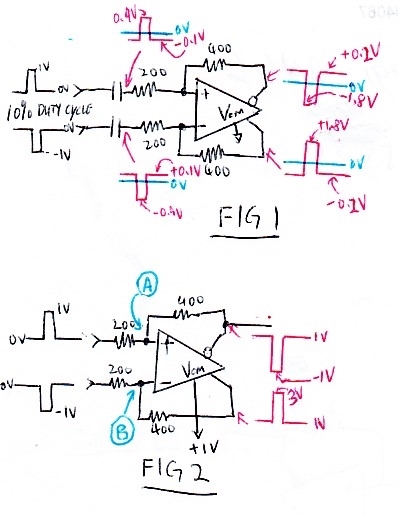Hi
I have question with the differential circuit above with gain of 400/200=2. In both cases, I have a differential input pulse base line at 0V and 1V amplitude as shown. The duty cycle of the pulse is 10%( say peak for 5nS and back to 0V for 45nS).
In Fig.1, I have AC blocking cap on both inputs. The Vcm is tied to ground so the common mode output voltage should be 0. BUT, if you look at the other side of the two capacitors, because of the 10% duty cycle, the base line of the input pulses are SHIFTED as shown. The base line of the +ve pulse has shifted to -0.1V and -ve pulse to +0.1V as shown due to the 10% duty cycle. This actually becomes differential mode voltage and CANNOT be eliminated. The base line of -ve output is at +0.2V and +ve output is at -0.2V as shown. So if I DC coupled to the next differential stage, the baseline will follow. This means I created an offset due to duty cycle of the input. Am I correct?
In Fig.2 I do DC coupled, but notice the Vcm=+1V. So the baseline of both outputs is 0V no matter what. If you look at the input side, it is driven by differential pulse with baseline at 0V. What will the base line voltage at point (A) and (B) in BLUE? Is it simple division and is +0.333V on both input of the differential amp?
Do you have any application notes to explain at these basic circuits for differential amps? Can you give me the link?
Thanks
Alan




